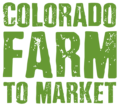Find out if you are covered by the FDA’s Food Safety Modernization Act (FSMA) Produce Safety Rule at www.coproducesafety.org.
Definition: Trees bearing fruit for consumption, including but not limited to apples, apricots, cherries, nectarines, peaches, pears, and plums.
Harvest/Post Harvest: Tree fruits should be picked at the peak of maturity. For peak quality, the fruit should be free from defects, such as insect injury, physical damage, scars and decay. Fruit continues to live and respire, even after it is picked. Although respiration cannot be halted completely, cooling fruit post harvest can extend its shelf life. Bruising is the most common defect in tree fruit; handle fruit with care to avoid soft spots. Apples, peaches, and pears are threatened by over 40 types of insects; therefore many orchards practice Integrated Pest Management (IPM). For an explanation of IPM, listen to PlantTalk.
- Culled means separation of damaged fruit from undamaged fruit. Under this guidance, for processors of citrus juices using treatments to fruit surfaces to comply with 21 CFR 120.24, FDA will consider tree-picked, undamaged citrus fruit to be “culled” for purposes of compliance with the juice HACCP regulation.
(Note: The definition of the term “culled” in 21 CFR 120.3(f) includes the requirement that the fruit is of U.S. Department of Agriculture (USDA) choice or higher quality, however, there is no current USDA standard for choice or higher quality.) - Fallen fruit means fruit that has fallen naturally from the tree to the ground in an orchard. It does not include mechanically harvested fruit, which is obtained by shaking the tree and collecting the fruit from the ground with appropriate mechanical machinery; also called grounders, windfall fruit, or drops.
Many local fruit producers sell boxes of their “seconds” at a reduced price for customers interested in making preserves or baking. Consumers may not be aware that the shelf life of damaged fruit, particularly soft fruit such as peaches, is very short and this fruit should be used within two days.
Food Safety: Rinsing tree fruit with fresh water prior to eating reduces the potential for food borne illness. Keep cut fruit chilled to maintain its quality and safety. Use proper time/temperature processing methods in an approved facility for canned products such as applesauce, whole peaches, pears or other tree fruit. For safe handling recommendations when offering samples, please see Farmers’ Market Vendor Guide for Preparing and Offering Food Samples.
* Washing fruits and vegetables with soap or detergent or using commercial produce washes is not recommended.
Waxing: Wax is sometimes used to lengthen the shelf life of tree fruit and has been used on fruits and vegetables since the 1920s. Fruit waxes are made from natural ingredients and are certified by the U.S. Food and Drug Administration to be safe to eat. They come from natural sources including carnauba wax, from the leaves of a Brazilian palm; candellia wax, derived from reed-like desert plants of the genus Euphorbia; and food-grade shellac, which comes from a secretion of the lac bug found in India and Pakistan. Many vegetables and fruits make their own natural waxy coating. After harvest, fresh produce may be washed to clean off dirt and soil – but such washing also removes the natural wax. Therefore, waxes are applied to some produce to replace the natural waxes that are lost. Waxes also help inhibit mold growth, protect produce from bruising, prevent other physical damage and disease, and enhance appearance. Waxes are used in very small amounts to provide a microscopic coating surrounding the entire product.
Wax coatings help retain moisture to maintain quality from farm to table including:
- Transportation from farm to market
- Display at stores and restaurants
- Handling by the end consumer
Good Agricultural Practices (GAPs): Good Agricultural Practices may be utilized during tree fruit production, harvest, and packing operations to reduce the potential for microbial contamination.
Ripening information for consumers: If peaches are purchased while still firm, store them on the counter in a brown paper bag to promote ripening. Once peaches become ripe, they should be stored in the fruit drawer of the refrigerator and enjoyed within a few days for best flavor and eating quality.
Distribution Method | Collapse All)
You are selling your product at a farmers’ market, CSA, roadside stand, or other direct to consumer outlet
Labeling: No specific labeling requirements. Unpackaged, single ingredient foods like fruits and vegetables do not need labels.
Sales Tax Liability: General sales tax information.
Weights and Measures: If you are selling your product by weight, you must follow the Colorado weights and measures requirements. Tree fruit might also be sold by count, refer to the fruits and vegetables section of weights and measures for guidelines.
You are selling your product to a store, restaurant, food cart, K-12 school, university, hospital, or other retail food establishment
Licensing: If you are selling products that you have grown, no specific licensing requirement for selling whole raw agricultural products in the wholesale market. If you are selling tree fruit that you have purchased directly from a Colorado grower or from a wholesaler, you will need a Farm Product Dealers License.
Labeling: The state does not require specific labels, however your buyer might have specific requirements. Check with your buyer for product identification and traceability requirements.
Sales Tax Liability: General sales tax information.
Weights and Measures: If you are selling your product by weight, you must follow the Colorado weights and measures requirements. Tree fruit might also be sold by count, refer to the fruits and vegetables section of weights and measures for guidelines.
Value Added Products: Canned fruit, jams and jellies, dried fruit, juices and cider
Related Links:
